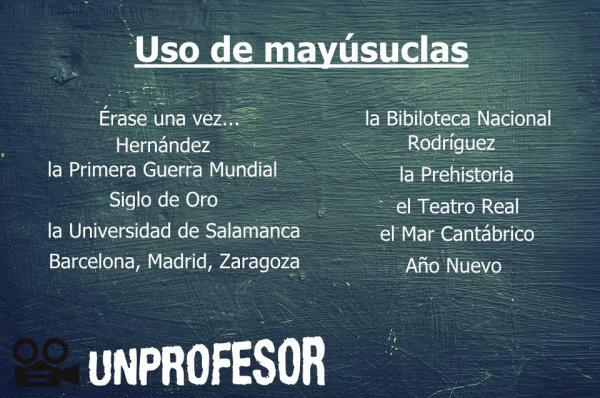CAPITAL LETTERING: Rules and Examples

The use of capital letters is one of the most controversial issues in Spanish spelling. The Spelling of the Spanish language (2010) points out that the use of capital letters It has to take into account various factors such as, for example, the type of text that is being written, the context of the text or the intentionality of the writer. As a general rule, writing in Spanish uses lowercase letters. However, it is possible to find some text written entirely in capital letters, as well as individual phrases or words.
In this article by a TEACHER we are going to study the capitalization through the spelling rules established by the Royal Spanish Academy (RAE), accompanying each of them with several examples.
Index
- Capitalization according to punctuation of the text
- Other uses of capital letters
- Capital letters in titles - According to the RAE
- Capitalization exercises - with solutions
- Solution to exercises
Capitalization according to the punctuation of the text.
The punctuation of a text requires, on certain occasions, the use of capital letters, generally in the word that follows the corresponding punctuation mark. Below we show you in which cases it is capitalization mandatory:
- The first word that starts a text: Once upon a time...
- The word that goes after a period: There is soccer tonight. My brother will watch the game at home.
- After ellipsis when they conclude the statement; that is, when they act as an end point: For the barbecue we need meat, bread, potatoes, beer... I'm in charge of making the list. However, when the ellipsis do not end the sentence, the word that follows after them must be written in lowercase: I don't know if I'll go to the movies... because I have many duties.
- After the two points, the word that follows must begin with a capital letter when it is a quote or verbatim word: As Socrates said: "I only know that I know nothing". Note that, as it is a verbatim quote, it must be enclosed in quotation marks. Similarly, if we are writing a letter, after the initial greeting, the word that follows the colon must be capitalized: Dear Ana: Thank you very much for your congratulations.
- In the case of interrogative (¿?) and exclamatory (¡!) phrases, the word that begins the next sentence will be capitalized when the question or exclamation is by itself a complete sentence. Let's see it through an example: What a joy to see you! I haven't heard from you for a long time. What news do you bring me today? The boss asked me as he entered the office.
In the previous examples we observe how in the first one, the exclamatory sentence is a statement with a full meaning independent of the phrase that follows, while in the second case, the following sentence refers directly to the interrogative phrase, so it must be written in lower case.
In this other lesson we will discover what is the Using case sensitive according to the RAE so that you are clear how to write correctly.

Image: Wild Side - WordPress.com
Other uses of capital letters.
Regardless of the punctuation marks in the text, there are a series of words that, according to the spelling rules, must always be written with an initial capital letter. They are as follows:
- Proper names of people, animals, cities and countries: Claudia, Diego, Pancho, Seville, Barcelona, Spain, Sweden. However, when the proper name of a geographical place is accompanied by a common name, it must be in lower case: the Duero River, the Cantabrian Sea, the Gredos Mountains. Faced with this rule, we find the exception of Iberian Peninsula which is due to the fact that it designates a place with its own character and identity, and not so much a purely geographical question.
- The last names: Hernández, Rodríguez, García, Díaz, as well as nicknames or pseudonyms: Alfonso X the Wise, El Greco, and the common names used par excellence to refer to God, Jesus Christ or the Virgin: the Creator, the Savior, the Most Pure. Similarly, common names used in personifications of abstract ideas such as Death, Evil, Greed.
- The nouns and adjectives that designate entities, administrative bodies, buildings, monuments or political parties, among others: the National Library, the University of Salamanca, the Democratic Party, the Ministry of Defense, the Royal Theater. Likewise, the names and adjectives that are part of the name of magazines or periodicals: El País, Journal of Theoretical and Applied Linguistics, Library of Spanish Authors.
- Abbreviations of entities, organizations, countries, etc. They are also capitalized: NGO (Non-Governmental Organization), USA. (United States), WHO (World Health Organization), U.E. (European Union). In this video of a PROFESSOR we explain the spelling rules for writing acronyms.
- The names of festivals: Christmas, Constitution Day, New Year, April Fair, Easter.
- Nouns that indicate times or events historical, social, political and cultural: Antiquity, the Middle Ages, the First World War, Prehistory, the Renaissance, the Baroque, the Golden Age.
There are also many doubts about the capital accentuation and in a PROFESSOR we will solve it for you.

Capital letters in titles - According to the RAE.
And what about the capital letters in the titles? You have to know that, according to the RAE, capital letters should only be used in the first letter of the first word. In fact, even if the title contains more than one word, the capital letter will only have to be placed on the first letter of all.
A example of it is the following:
- Spanish language spelling - CORRECT
- Spelling of the Spanish Language - INCORRECT
Of course: in the event that the title has a own name, then Yes that we must put these names in capital letters because, as we have seen, it is a regulation of the Spanish language. Here are some examples in this regard:
- The Ingenious Gentleman Don Quijote of La Mancha
- The incredible and sad story of candida Eréndira
Capitalization exercises - with solutions.
To finish this lesson on the rules of capitalization, here we are going to leave you a series of exercises so that you can put into practice the knowledge that we have explained in the steps previous. In the next section you will have the solutions to the exercises so that you can check your results for yourself.
Exercise: Indicates if the words highlighted in bold are correct or misspelled:
- I like the subject of Spanish language, and you?
- The other day I was introduced to Gonzalo Martinez. It is a charm.
- I would like to visit one ngo some summer.
- I love to celebrate the New Year with you.
- The river Ebro It is one of the main rivers in the country.
Solution to exercises.
To finish, here are the solutions to the previous exercises:
- I like the subject of Spanish language, and you? - WRONG
- The other day I was introduced to Gonzalo Martinez. It is a charm. - WELL
- I would like to visit one ngo some summer. - WRONG
- I love to celebrate the New Year with you. - WELL
- The river Ebro It is one of the main rivers in the country. - WELL
If you want to read more articles similar to Capitalization - Rules and Examples, we recommend that you enter our category of Orthography.
Bibliography
- De Sousa, J. M. (2007). Dictionary of the use of uppercase and lowercase letters (Vol. 160). Trea editions.
- Española, R. TO. CAPITAL LETTERS ACCENTUATION.
- Romero, C. AND. D. (2011). Review of "Spelling of the Spanish language" of the Royal Spanish Academy (RAE) - Association of Academies of the Spanish Language (ASALE). Onomázein, (24), 403-409.



